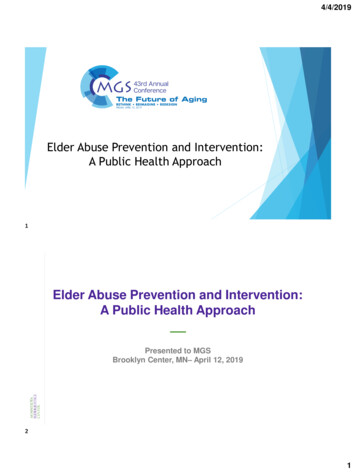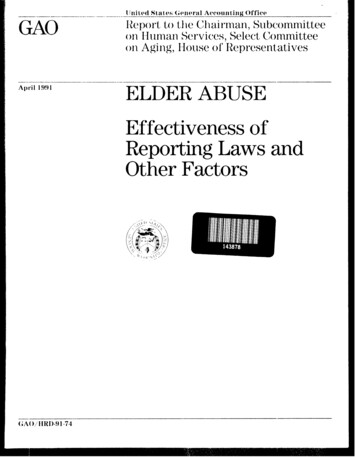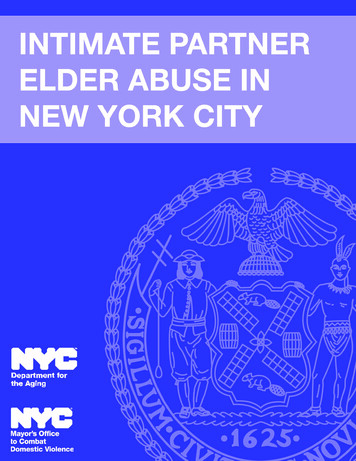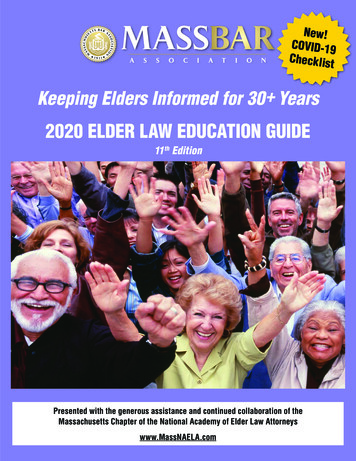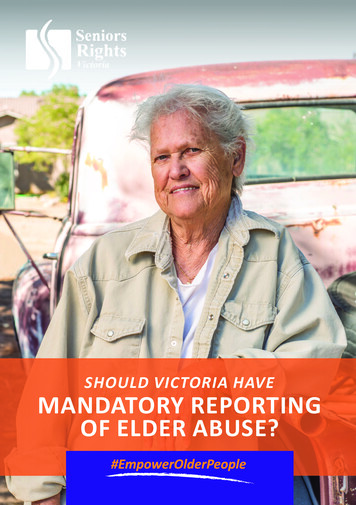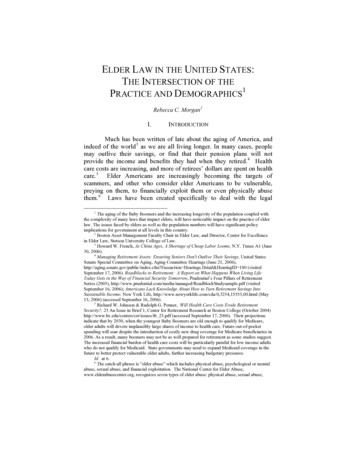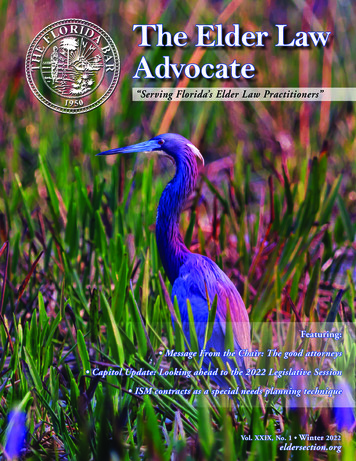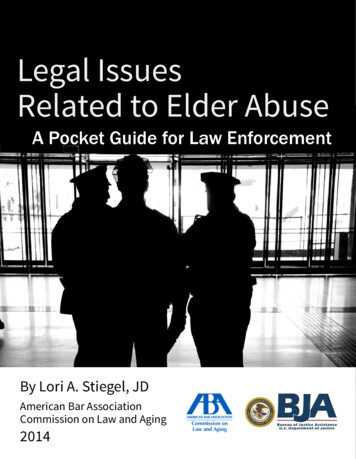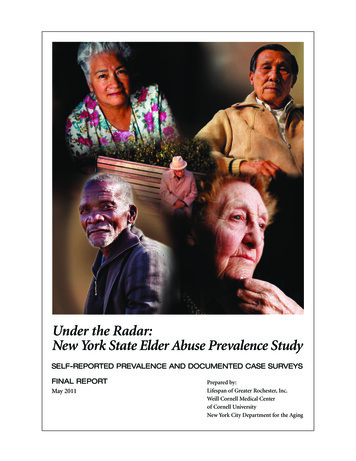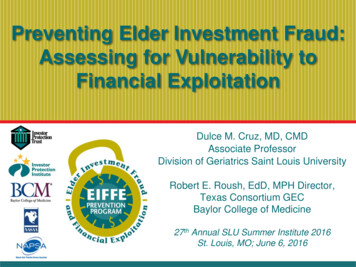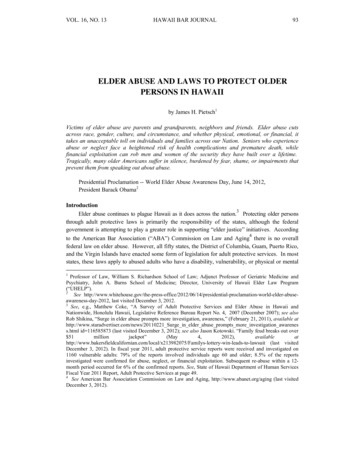
Transcription
VOL. 16, NO. 13HAWAII BAR JOURNAL93ELDER ABUSE AND LAWS TO PROTECT OLDERPERSONS IN HAWAIIby James H. Pietsch1Victims of elder abuse are parents and grandparents, neighbors and friends. Elder abuse cutsacross race, gender, culture, and circumstance, and whether physical, emotional, or financial, ittakes an unacceptable toll on individuals and families across our Nation. Seniors who experienceabuse or neglect face a heightened risk of health complications and premature death, whilefinancial exploitation can rob men and women of the security they have built over a lifetime.Tragically, many older Americans suffer in silence, burdened by fear, shame, or impairments thatprevent them from speaking out about abuse.Presidential Proclamation -- World Elder Abuse Awareness Day, June 14, 2012,President Barack Obama2Introduction3Elder abuse continues to plague Hawaii as it does across the nation. Protecting older personsthrough adult protective laws is primarily the responsibility of the states, although the federalgovernment is attempting to play a greater role in supporting “elder justice” initiatives. According4to the American Bar Association (“ABA”) Commission on Law and Aging there is no overallfederal law on elder abuse. However, all fifty states, the District of Columbia, Guam, Puerto Rico,and the Virgin Islands have enacted some form of legislation for adult protective services. In moststates, these laws apply to abused adults who have a disability, vulnerability, or physical or mental1Professor of Law, William S. Richardson School of Law; Adjunct Professor of Geriatric Medicine andPsychiatry, John A. Burns School of Medicine; Director, University of Hawaii Elder Law Program(“UHELP”).2See reness-day-2012, last visited December 3, 2012.3See, e.g., Matthew Coke, “A Survey of Adult Protective Services and Elder Abuse in Hawaii andNationwide, Honolulu Hawaii, Legislative Reference Bureau Report No. 4, 2007 (December 2007); see alsoRob Shikina, “Surge in elder abuse prompts more investigation, awareness,” (February 21, 2011), available athttp://www.staradvertiser.com/news/20110221 Surge in elder abuse prompts more investigation awareness.html id 116585873 (last visited December 3, 2012); see also Jason Kotowski. “Family feud breaks out over ilys-lottery-win-leads-to-lawsuit (last visitedDecember 3, 2012). In fiscal year 2011, adult protective service reports were received and investigated on1160 vulnerable adults: 79% of the reports involved individuals age 60 and older; 8.5% of the reportsinvestigated were confirmed for abuse, neglect, or financial exploitation. Subsequent re-abuse within a 12month period occurred for 6% of the confirmed reports. See, State of Hawaii Department of Human ServicesFiscal Year 2011 Report, Adult Protective Services at page 49.4See American Bar Association Commission on Law and Aging, http://www.abanet.org/aging (last visitedDecember 3, 2012).
VOL. 16, No. 13HAWAII BAR JOURNAL94impairment. Some states have specific elder protective services laws or programs, but Hawaii does5not. While there is no specific overall “elder abuse” law in Hawaii, there are a variety of laws andinterventions that protect older adults. After addressing federal and other national initiatives, thisarticle will highlight some of the most commonly used laws and interventions in Hawaii to combatelder abuse.Federal InitiativesOne major federal initiative to bring federal leadership to the issue of elder abuse is the6Elder Justice Act (“EJA”) legislation.However, the promise of the EJA has yet to be met7according to both the ABA Commission on Law and Aging and the National Committee on Elder5See Lori Stiegel & Ellen Klem, Information About Laws Related to Elder Abuse, available on for APS-IA-LTCOP citations chart.pdf (last visitedDecember 3, 2012). Each of the fifty states, the District of Columbia, Guam, Puerto Rico, and the VirginIslands have authorized adult protective services statutes. These statutes vary widely based on who may beeligible for services and the types of abuse that may be actionable. At the same time, federal laws such as theOlder Americans Act (42 U.S.C. § 3002, et seq.) do little more than authorize funds for local awareness andcoordination endeavors. Unlike federal laws on child abuse and domestic violence which fund services andshelters for victims, there is no comparable federal law on elder abuse.6See Pub. L. No. 111-148 (“The Elder Justice Act”). The Elder Justice Act was passed by both the Senateand the House in the Health Care Reform Act of 2009 H.R. 3590 and signed into law by President BarackObama. In Section 3 of the bill, the purposes of this Act are listed as follows:(1) To enhance the social security of the Nation by ensuring adequate public-privateinfrastructure and resolving to prevent, detect, treat, understand, and intervene in, andwhere appropriate, aid in the prosecution of, elder abuse, neglect, and exploitation.(2) To bring a comprehensive approach to preventing and combating elder abuse, neglect,and exploitation, a long invisible problem that afflicts the most vulnerable among theaging population of the United States.(3) To raise the issue of elder abuse, neglect, and exploitation to national attention, and tocreate the infrastructure at the Federal, State, and local levels, to ensure that individualsand organizations on the front lines, who are fighting elder abuse, neglect, and exploitationwith scarce resources and fragmented systems, have the resources and information neededto carry out their fight.(4) To bring a comprehensive multidisciplinary approach to elder justice.(5) To set in motion research and data collection to fill gaps in knowledge about elderabuse, neglect, and exploitation.(6) To supplement the activities of service providers and programs, to enhance training,and to leverage scarce resources efficiently, in order to ensure that elder justice receivesthe attention it deserves as the Nation's population ages.(7) To recognize and address the role of mental health, disability, dementia, substanceabuse, medication mismanagement, and family dysfunction problems in increasing andexacerbating elder abuse, neglect, and exploitation.(8) To create short- and long-term strategic plans for the development and coordination ofelder justice research, programs, studies, training, and other efforts nationwide.(9) To promote collaborative efforts and diminish overlap and gaps in efforts indeveloping the important field of elder justice.(10) To honor and respect the right of all individuals with diminished capacity todecisionmaking autonomy, self-determination, and dignity of choice.(11) To respect the wishes of individuals with diminished capacity and their familymembers in providing supportive services and care plans intended to protect elders fromabuse, neglect (including self-neglect), and exploitation.7See Lori Stiegel, Elder Justice Act Becomes Law, But Victory Is Only Partial, 31 BIFOCAL 4, (MarchApril 2010).
VOL. 16, NO. 13HAWAII BAR JOURNAL958Abuse (“NCEA”). The NCEA has defined the major types of elder abuse as physical abuse, sexualabuse, emotional or psychological abuse, neglect, abandonment, financial or material exploitation,9and self-neglect.10The NCEA was one of the major organizations in the Elder Justice Coalition thatpartnered to help pass the Elder Justice Act. While acknowledging that “[d]ifferences in State laws8See National Center on Elder Abuse Administration on Aging, http://www.ncea.aoa.gov (last visitedDecember 3, 2012). According to its website, “[t]he NCEA, directed by the U.S. Administration on Aging, iscommitted to helping national, state, and local partners in the field be fully prepared to ensure that olderAmericans will live with dignity, integrity, independence, and without abuse, neglect, and exploitation.”9See National Center on Elder Abuse, Major Types of Abuse,http://www.ncea.aoa.gov/NCEAroot/Main Site/FAQ/Basics/Types Of Abuse.aspx (last visited December 3,2012). The NCEA defines these major types of abuse as follows:Physical abuse is defined as the use of physical force that may result in bodily injury,physical pain, or impairment. Physical abuse may include but is not limited to such acts ofviolence as striking (with or without an object), hitting, beating, pushing, shoving,shaking, slapping, kicking, pinching, and burning. In addition, inappropriate use of drugsand physical restraints, force-feeding, and physical punishment of any kind also areexamples of physical abuse.Sexual abuse is defined as non-consensual sexual contact of any kind with an elderlyperson. Sexual contact with any person incapable of giving consent is also consideredsexual abuse. It includes, but is not limited to, unwanted touching, all types of sexualassault or battery, such as rape, sodomy, coerced nudity, and sexually explicitphotographing.Emotional or psychological abuse is defined as the infliction of anguish, pain, or distressthrough verbal or nonverbal acts. Emotional/psychological abuse includes but is notlimited to verbal assaults, insults, threats, intimidation, humiliation, and harassment. Inaddition, treating an older person like an infant; isolating an elderly person from his/herfamily, friends, or regular activities; giving an older person the "silent treatment;" andenforced social isolation are examples of emotional/psychological abuse.Neglect is defined as the refusal or failure to fulfill any part of a person's obligations orduties to an elder. Neglect may also include failure of a person who has fiduciaryresponsibilities to provide care for an elder (e.g., pay for necessary home care services) orthe failure on the part of an in-home service provider to provide necessary care. Neglecttypically means the refusal or failure to provide an elderly person with such life necessitiesas food, water, clothing, shelter, personal hygiene, medicine, comfort, personal safety, andother essentials included in an implied or agreed-upon responsibility to an elder.Abandonment is defined as the desertion of an elderly person by an individual who hasassumed responsibility for providing care for an elder, or by a person with physicalcustody of an elder.Financial or material exploitation is defined as the illegal or improper use of an elder'sfunds, property, or assets. Examples include, but are not limited to, cashing an elderlyperson's checks without authorization or permission; forging an older person's signature;misusing or stealing an older person's money or possessions; coercing or deceiving anolder person into signing any document (e.g., contracts or will); and the improper use ofconservatorship, guardianship, or power of attorney.Self-neglect is characterized as the behavior of an elderly person that threatens his/herown health or safety. Self-neglect generally manifests itself in an older person as a refusalor failure to provide himself/herself with adequate food, water, clothing, shelter, personalhygiene, medication (when indicated), and safety precautions.The definition of self-neglect excludes a situation in which a mentally competent olderperson, who understands the consequences of his/her decisions, makes a conscious andvoluntary decision to engage in acts that threaten his/her health or safety as a matter ofpersonal choice.10See Elder Justice Coalition, http://www.elderjusticecoalition.com (last visited December 3, 2012).According to its website, the Elder Justice Coalition was formally launched on February 10, 2003, to coincide
VOL. 16, No. 13HAWAII BAR JOURNAL96and practices in the areas of elder abuse, neglect, and exploitation lead to significant disparities inprevention, protective and social services, treatment systems, and law enforcement, and lead toother inequities,” nowhere in the EJA is there a provision for a federal elder abuse law, nor is there11any requirement or real encouragement for the states to specifically include old age as a basis forinclusion in any state adult protective service law.As evidenced by the substantial number of articles listed by the Clearinghouse on Abuse12legal and ethical dilemmas, including issues of ageism,and Neglect of the Elderly (“CANE”),13abound in addressing elder abuse issues.Using age classifications to protect individuals from14Although definitions varyharm has been considered Constitutional under a rational basis test.from the use of specific ages, e.g. 60 or 65, or through such terms as “advanced age” or “thewith the introduction of the Elder Justice Act (S. 333), which was introduced by Senators John Breaux andOrrin Hatch. The Coalition has five founding organizational members: the National Committee for thePrevention of Elder Abuse (NCPEA), the National Academy of Elder Law Attorneys (NAELA), the NationalAssociation of State Units on Aging (“NASUA”), the National Association of Adult Protective ServiceAdministrators (“NAAPSA”), and the National Association of State Long-Term Care Ombudsman Programs(“NASOP”). NCPEA has assumed the additional role of providing the physical and administrative home forthe Coalition.11See Age Discrimination in Employment Act of 1967 (Pub. L. No. 90-202 as amended).Labor, Age Limitation, 29 U.S.C. § 631; Programs for Older Americans, The Public Health and Welfare,42 U.S.C. § 3002 (35); The Social Security Act, Federal Old-Age, Survivors, and Disability InsuranceBenefits, 42 U.S.C. §§ 401-433. What constitutes “old age” is a foundational issue to ask but is very difficultto answer. Is it chronological, biological, psychological, functional or social age? The federal governmentand the states have used different ages for different purposes. For example: Age 40 is the threshold age underthe federal Age Discrimination in Employment Act. See 29 U.S.C. § 631. Age 60 is the age of eligibility formost services and programs under the Older Americans Act. (“The term ‘older individual’ means anindividual who is 60 years of age or older”). See 42 U.S.C. § 3002 (35). Age 62 is the age a worker is eligiblefor Social Security early retirement benefits. See Title III of the Social Security Act, 42 U.S.C. §§401-433.Age 65 was the standard age for full Social Security retirement benefits, but this is increasing for people bornafter 1938 and will go from 65 to 67 depending upon the year of birth, Id. State “Elder Abuse” statutes varyon age criteria for protective services. See, e.g., Center for Elders and Courts, “Elder Abuse tedDecember 3, 2012.12The Clearinghouse on Abuse and Neglect of the Elderly, http://www.cane.udel.edu/ (last visited December3, 2012). Located at the University of Delaware, CANE is the nation's largest archive of published research,training resources, government documents, and other sources on elder abuse.13See, e.g., National Center on Elder Abuse, Ethical Concerns in Addressing Elder Abuse - CEAroot/Main Site/Library/CANE/CANE Series/CANE ethicalconcerns.aspx(last visited December 3, 2012). See also National Center on Elder Abuse, Ageism, available athttp://www.ncea.aoa.gov/NCEAroot/Main Site/Library/CANE/CANE Series/CANE ageism.aspx(lastvisited December 3, 2012).14See, e.g., Essling v. Markman, 335 N.W. 2d. 237 (Minn. 1983) (Involving the State of Minnesota’s attemptto curb abuses by the insurance industry in selling policies to persons over 65). The Minnesota Supreme Courtaddressed, along with a right to contract claim, a claim that the State had wrongfully interfered with their rightto privacy because of their age. They claim this deprivation occurred without due process of law. CitingMassachusetts Board of Retirement v. Murgia, 427 U.S. 307 (1976), the court found that, absent afundamental right or suspect class, minimal judicial scrutiny is appropriate, that age has never been considereda suspect classification, and, accordingly, minimal judicial scrutiny is appropriate. The court went on to findthat the law should be upheld because the classification is rationally related to achievement of a legitimategovernmental purpose.
VOL. 16, NO. 13HAWAII BAR JOURNAL97infirmities of old age,” at least fifteen states use age as a criterion for providing protective services15to seniors who are victims of abuse.Elder Abuse in Hawaii and Laws to Protect Abused ElderlyCombating elder abuse in Hawaii involves both federal and state laws and relies on federal andstate agencies as well as non-governmental organizations, legal and health care professionals, familymembers and volunteers. Like many other states, Hawaii has addressed the issue of elder abusethrough the legislative process. The Hawaii State Legislature has not been consistent in its philosophyrelating to whether or not specific protection should be extended to older persons. This inconsistencycan be seen through the evolution of the laws Hawaii has adopted relating to elder abuse.The Law of the Splintered Paddle16Nearly two centuries ago, King Kamehameha the Great gave Hawaii its first law. Known17Hawaii’s first law establishes aas the Law of the Splintered Paddle, or Mamala-hoe Kanawai,history and tradition of protecting older persons. The initial edict of the King required that the elderlytogether with women and children should be protected from harm while they slept by the roadside,18under the most severe of penalties.The Law of the Splintered Paddle continues to be a part of the15Conn. Gen. Stat. §17b.450; Ga. Code Ann. § 30-5-31; Ill. Comp. Stat. ch. 320, §20/2(e);); La. Rev. Stat.Ann. §93.3(C); Mo. Ann. Stat. § 660.350 ; N.D. Cent. Code §12.1-31-07 (c.); N.C. Gen. Stat. §108A-101(d);Ohio Rev. Code Ann. §5101.60(B); Or. Rev. Stat. §124.005(2); S.C. Code Ann. §43-35-10(11); S.D. CodifiedLaws §22-46-1(2); Tenn. Code Ann. §71-6-102(2); Tex. Hum. Res. Code Ann. §48.002(1); Wis. Stat. Ann.§940.285 (b), (e); Wyo. Stat. Ann. §35-20-102(a)(vi).16King Kamehameha I united all of the islands except Kauai during his reign.17The first edict declared by Kamehameha was the Law of the Splintered Paddle, based on his ownexperience on a fateful day which taught him that human life was precious and deserved respect:O my people,Honor thy god;Respect alike (the rights of) men great and humble;See to it that our aged, our women, and our childrenLie down to sleep by the roadsideWithout fear of harm.Disobey and die.The Law of The Splintered Paddle.18Id. Traditionally, older persons in Hawaii have been shown respect and deference and were valued for thelessons they imparted to following generations. Some lament the changes in modern society. See, e.g., ClaireKu'uleilani Hughes, “Traditional behaviors and Kupuna,” KA WAI OLA, THE LIVING WATER OF OHA(Office of Hawaiian Affairs), page 9 (August 2008).Early Hawaiians were often characterized as gentle, gracious, generous and polite. And that is becausechiefs and commoners alike were taught the traditional values of humility, kindness and generosity. Kupunataught children of all social strata the courtesies and behaviors required with their elders, particularly, withtheir chiefs. Good breeding was demonstrated by acting and speaking with courtesy and walking and sittingwith dignity.By the mid-1800s, Hawaiian historian Kepelino lamented, “But, today these goodteachings are being lost and the arrogant ways of the Americans are common here.”. . .Interestingly, Kepelino saw the traditionally taught courtesies and behaviors were beinglost and replaced, 150 years ago. Admittedly, today courtesy is no longer a demonstratednorm. And sadly, speaking with respect for elders has also waned. . . Traditionally, Kupuna held an enviable position in the Hawaiian family. Kūpuna wereconsidered wise and accomplished. Kupuna were the constant, steadying and positiveinfluence for both makua (ancestors) and mo opuna (grandchildren). Kūpuna observedand continued to gently guide their own children as they settled into the role of familyproviders. Kupuna also focused on teaching mo opuna the family history, values,
VOL. 16, No. 13HAWAII BAR JOURNALcurrent State Constitution,1998but now only serves as a “symbol of the State’s concern for public20safety.”The cultural conditions that existed in the times of King Kamehameha I have changed andelder abuse in Hawaii takes the same form as in other states.21 In order to address these many formsof abuse, Hawaii has adopted a number of laws.The Old Dependent Adult Protective Services ActIn 1989, the Hawaii State Legislature enacted the Dependent Adult Protective Services Act22(“DAPSA”).23Early proposed legislation included specific reference to older personsbut that24provision was deleted by the legislature in the final version that ultimately became law. Despite theprotests of those who questioned the constitutionality of laws intended to afford greater protections25to older persons, the DAPSA did recognize the State’s interest in protecting elders. The statedpurpose of DAPSA was to protect adults at a high risk of abuse, neglect, and financial exploitation due26To be entitled to protection under the previous law, individuals mustto their dependency on others.have been “dependent adults,” defined as persons at least 18 years old, having a mental or physicalimpairment, being “dependent upon another person, a care organization, or a care facility for personal27health, safety, or welfare,” due to the impairment.The New Adult Protective Services LawThe DAPSA statute was amended by the legislature in 2008, but failed to specifically28address “elder abuse.”The new Adult Protective Services statute (“APS”) made significantchanges to the law but under the new APS law, like DAPSA, vestiges of the original draftDependent and Elder Abuse bill remain and elders continue to be mentioned as an important29segment of the population deserving protection.behaviors and courtesies taught to them by their Kupuna. The 21st century has broughtmore challenges and changes to the Hawaiian family system and many are not desirable.Id.19HAW. CONST. Art. IX, §10 (1978).Id. (“The law of the splintered paddle, mamala-hoe kanawai, decreed by Kamehameha I – Let everyelderly person, woman and child lie by the roadside in safety–shall be a unique and living symbol of theState’s concern for public safety.”)21See note 10 supra.22See 1989 Haw. Sess. Laws 189, codified at HAW. REV. STAT. Part X, Chapter 346 (1989).23346 HAW.REV.STAT. §221 (1989) (Dependent Adult Protective Services). The original proposal wasentitled, Elder and Dependent Adult Protective Services Act, which would have included under its scope botholder persons (60 years of age or above--original draft 1988 draft proposal on file with author) and “dependentadults” between the ages of 18 and 59. Although the statute provides protections to all persons who are 18years of age or over, HAW. REV. STAT. § 346-221 emphasizes “[t]he legislature recognizes that citizens of theState who are elders and mentally or physically impaired constitute a significant and identifiable segment ofthe population and are particularly subject to risks of abuse, neglect and exploitation.”24HAW. REV. STAT. § 346-224 provides that “[a]n individual shall not be involuntarily subjected to theprovisions of this part solely based on advanced age.”25See HAW. REV. STAT. § 346-221 (1993).26HAW. REV. STAT. § 346-221 (1993).27HAW. REV. STAT. § 346-222 (1993).28See Act 154, S.B. No. 2150, S.D. 2, H.D. 2, C.D. 1 Hawaii State Legislature (2008).29Id. Section I, modifying HAW. REV. STAT. § 346-221:While advanced age alone is not sufficient reason to intervene in a person’s life, thelegislature finds that many elders have become subjects of abuse, neglect, andexploitation. Substantial public interest exists to ensure that this segment of the populationreceives protection.20
VOL. 16, NO. 13HAWAII BAR JOURNAL99The new law removed “dependent” from its title and is now called “Adult Protective30As an overview, changes include deleting the term “dependent,” adding a moreServices.”inclusive term, “vulnerable,” and giving the Department of Human Services the jurisdiction toinvestigate cases of abuse of a vulnerable adult who has incurred abuse or is in danger of abuse ifimmediate action is not taken.Under the new law, mandated reporters are required to report cases of abuse of avulnerable adult who has incurred abuse or is in danger of abuse if immediate action is not takenand the department is required to investigate.Under the new law, a “vulnerable adult” means a person eighteen years of age or older who,because of mental, developmental, or physical impairment, is unable to: Communicate or make responsible decisions to manage the person’s own care orresources; Carry out or arrange for essential activities of daily living; or31 Protect oneself from abuse.Under the new law, “abuse” means any of the following, separately or in combination: Physical abuse, Psychological abuse, Sexual abuse, Financial exploitation, Caregiver neglect, or32 Self-neglect.“Caregiver neglect” means the failure of a caregiver to exercise that degree of care for avulnerable adult that a reasonable person with the responsibility of a caregiver would exercisewithin the scope of the caregiver’s assumed, legal, or contractual duties, including but not limitedto the failure to: Assist with personal hygiene, Protect the vulnerable adult from abandonment, Provide, in a timely manner, necessary food, shelter, or clothing, Provide, in a timely manner, necessary health care, access to health care,prescribed medication, psychological care, physical care, or supervision; Protect the vulnerable adult from dangerous, harmful, or detrimental drugs, Protect the vulnerable adult from health and safety hazards, or33 Protect the vulnerable adult from abuse by third parties.“Self-neglect” means: A vulnerable adult’s inability or failure, due to physical or mentalimpairment, or both, to perform tasks essential to caring for oneself, including but not limited to: Obtaining essential food, clothing, shelter, and medical care, Obtaining goods and services reasonably necessary to maintain minimum standardsof physical health, mental health, emotional well-being, and general safety, Management of one’s financial assets, and The vulnerable adult appears to lack sufficient understanding or capacity to make30313233HAW. REV. STAT. Chap. 346-221, et seq.(2009).HAW. REV. STAT. § 346-224 (2009).HAW. REV. STAT. § 346-222 (2009) (Definitions).Id.
VOL. 16, No. 13HAWAII BAR JOURNAL100or communicate responsible decisions and appears to be exposed to a situation or34condition that poses an immediate risk of death or serious physical harm.Intervention is initiated by a report to the Department of Human Services’ (“DHS”) AdultIntake.35 The report may be made by a mandated reporter36 or any other person who has reason tobelieve that a vulnerable adult has incurred abuse or is in danger of abuse if immediate action is nottaken.37 If the abuse criteria are met, the report is sent to the Adult Protective Services Unit of DHS forinvestigation.38 However, DHS must have the consent of the victim before an investigation orprotective action can commence.39 A person required under the law to file a report who knowinglyfails to do so, or willfully prevents another from reporting the abuse, may be subject to prosecution andmay be guilty of a petty misdemeanor.40 Further, immunity is granted to anyone making a report ingood faith who might otherwise have incurred liability.41The goal of protective services offered by DHS is to remedy abuse, neglect, or exploitation ofvulnerable adults.42 The Hawaii Administrative Rules details how adult protective services areprovided throughout the state upon receiving a report.43The DHS screens each report of vulnerable adult abuse received to determine whether thesubject of the report is a vulnerable adult who has incurred abuse or is in danger of abuse ifimmediate action is not taken.44 If these conditions are met, the vulnerable adult abuse report isaccepted for investigation by the DHS but when those provisions are not met, the DHS providesinformation, referral, or consultation services as appropriate.45The DHS is required to take every good faith effort to maintain the confidentiality of thereporter's identity pursuant to section 346-225 of Hawaii Revised Statutes46 but instances ofvulnerable adult abuse that may involve a crime are reported to the police or appropriate lawenforcement agency with or without the adult's consent.47Investigations include but are not limited to:1. Reasonable efforts to have face to face contact with the vulnerable adult and allegedperpetrators of abuse using police assistance as necessary in accordance with section 346-229, ofthe statute;2. Collateral contacts as needed with others such as family members, friends of thevulnerable adult, and professionals who may have information about the vulnerable adult relevantto the investigation; and34Id.HAW. REV. STAT. § 346-224 (2009).36See HAW. REV. STAT. § 346-224 (2009). Mandated reporters include licensed or registered professionals ofhealing arts, physicians, nurses, pharmacists, employees or officers of any public or private agency orinstitution providing medical services, law enforcement, and employees or officers of any adult residentialcare home or similar institution.37HAW. REV. STAT. § 346-224 (2009).38HAW. REV. STAT. § 346-227 (2009).39HAW. REV. STAT. § 346-230 (2009).40HAW. REV. STAT. § 346-224(e) (2009).41HAW. REV. STAT. § 346-250 (2009).42Haw. Admin R. § 17-1421-1.43Haw. Admin. R. § 17-1421-4 Geographic areas of service, provides that protective services for vulnerableadul
shelters for victims, there is no comparable federal law on elder abuse. 6 See Pub. L. No. 111-148 ("The Elder Justice Act"). The Elder Justice Act was passed by both the Senate and the House in the Health Care Reform Act of 2009 H.R. 3590 and signed into law by President Barack Obama.
